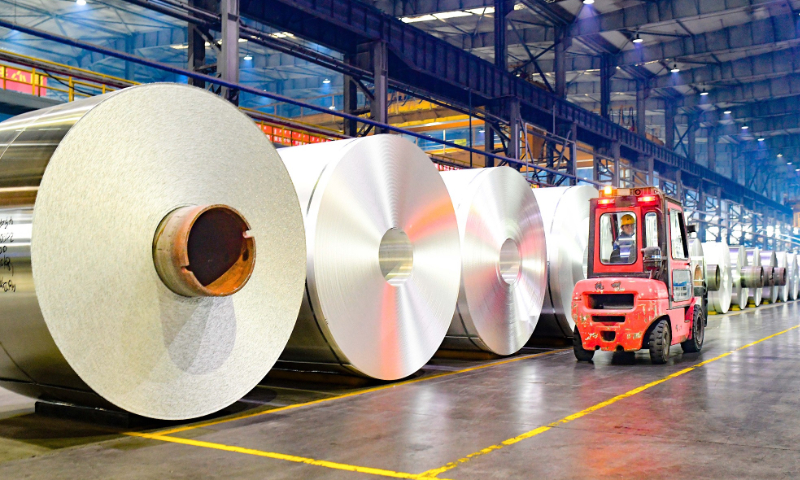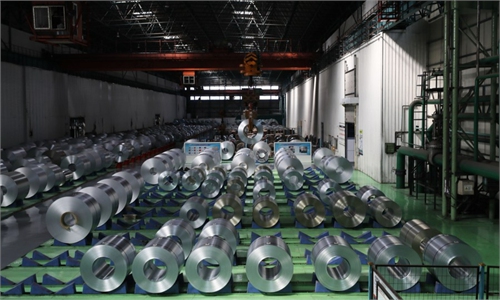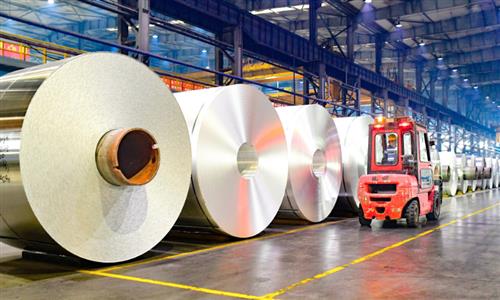
Operations are underway on the high-end aluminum foil production line at Inner Mongolia Liansheng new energy materials Co., Ltd., Tongliao, North China's Inner Mongolia Autonomous Region on February 19, 2023. Photo: VCG
The US is still the world's largest buyer of Chinese aluminum and aluminum products, Chinese data revealed, after six years of US suppression of China's exports of aluminum products since 2017.
Industry analysts said that it indicates the high dependence of the US market on China's aluminum products, adding that the two countries have a close relationship across the aluminum industrial chain.
The US International Trade Commission, following a review of aluminum imports from China, said this month that the revocation of the existing anti-dumping and countervailing duty orders on aluminum foil from China, would likely lead to continuation or recurrence of material injury within a reasonably foreseeable time. So, the existing orders on imports of this product from China will remain in place.
Due to broad use of aluminum in aviation, new energy, military armaments and other areas, the US regards the aluminum industry as a strategic industry that concerns its national security.
Since 2017, in addition to imposing high anti-dumping duty and countervailing tax on China's three major aluminum materials including aluminum foil, aluminum sheet and aluminum extrusions, it also imposed a 10-percent tariff on China's aluminum imports.
Under the US' intensive suppression, China's aluminum foil exports to the US fell rapidly from 149,000 tons in 2017 to 57,400 tons in 2021, and the US has dropped from being once the largest buyer of Chinese aluminum foil to the 9th place.
However, despite the fact that the US government has taken great pains to restrict China's aluminum industry for many years, data showed that it has remained the world's largest buyer of China's aluminum and aluminum products during the past six years.
According to Chinese customs data, industry organization Sunlight Metals said that US imports of aluminum products from China began to decline after 2017 due to its trade restrictive measures, but began to rebound in 2019.
In terms of export value, since 2009, the US surpassed South Korea to become China's largest export destination for aluminum products, a position it has retained now.
Dong Chunming, the head of the company, told the Global Times on Wednesday that the US trade restrictions have had the biggest impact on China's aluminum exports, but exports of aluminum products and wheel-related products to the US are still growing.
Over the past 20 years, China has exported a total of 10.87 million tons of aluminum and its products to the US, accounting for 9.9 percent of the total exports. The cumulative exports to the US amounted to $44.5 billion, accounting for 13.2 percent of all aluminum exports.
Dong noted that despite the US suppression, the country is still the world's largest buyer of China's aluminum and aluminum products, which showed that the US market is highly dependent on China's aluminum supply, and that the two countries share a close relationship across the aluminum industry chain.
Analysts noted that the increasing imports of Chinese aluminum products from the US and other countries reflected the high international competitiveness of Chinese aluminum sector.
In 2022, China exported a total of 10.11 million tons of aluminum products, an increase of 7.7 percent over the previous year, reaching a total value of $46.93 billion, up 19 percent. In 2022, China's aluminum and aluminum products were exported to more than 200 countries and regions around the world.
Dong said that in the context of the globalization of trade in the aluminum industry, the multiple industrial protection measures taken by the US have had limited effect, but has brought negative impact on the industry of the two countries.
US restrictions have increased costs for American businesses, while also affecting China's exports of aluminum products to the US, weakening the competitiveness and export earnings of Chinese enterprises, Dong noted.
Huo Jianguo, a vice chairman of the China Society for World Trade Organization Studies in Beijing, told the Global Times that aluminum trade between China and the US continued to grow amid the US' trade restrictions, demonstrating inseparable industrial pattern of the two countries, which is the strong driving force inherent in the China-US trade.
Huo noted that in the economic globalization, the US should seriously implement the commitment of not seeking to "decouple from China", so that China-US relations can be stabilized.



